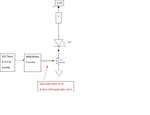eengr
Member level 4
Hi there
I am trying to build a circuit that turns a LED ON after 24 hours and then LED should stay ON after that. The solution needs to be without using any micro controller. I am planning to use a binary counter IC 4040 fed at Clock Input from a 555 timer. The Q12 output of 4040 would go HIGH after 24 hours for the configuration shown below in the block level diagram. This output will turn the NMOSFET and LED ON. The problem I have is that after next 24 hours this output would go LOW again for another 24 hours causing the LED to go OFF for another 24 hours. I would like to have some sort of latch at 4040 output that keeps this LED ON once 1st 24 hours are lapsed. I thought about using D type flip flop but this also requires Enable line and I am not sure how to control the Enable line in sync with this 24 hr output from 4040. Any help would be greatly appreciated.
555 Timer & 4040 are powered from same 3.3V rail as used for LED/resistor
I am trying to build a circuit that turns a LED ON after 24 hours and then LED should stay ON after that. The solution needs to be without using any micro controller. I am planning to use a binary counter IC 4040 fed at Clock Input from a 555 timer. The Q12 output of 4040 would go HIGH after 24 hours for the configuration shown below in the block level diagram. This output will turn the NMOSFET and LED ON. The problem I have is that after next 24 hours this output would go LOW again for another 24 hours causing the LED to go OFF for another 24 hours. I would like to have some sort of latch at 4040 output that keeps this LED ON once 1st 24 hours are lapsed. I thought about using D type flip flop but this also requires Enable line and I am not sure how to control the Enable line in sync with this 24 hr output from 4040. Any help would be greatly appreciated.
555 Timer & 4040 are powered from same 3.3V rail as used for LED/resistor
